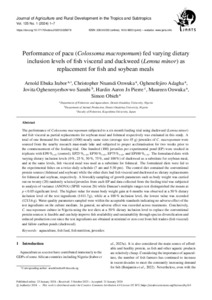| dc.date.accessioned | 2024-02-23T14:07:56Z | |
| dc.date.available | 2024-02-23T14:07:56Z | |
| dc.date.issued | 2024-01-23 | |
| dc.identifier | doi:10.17170/kobra-202312229279 | |
| dc.identifier.uri | http://hdl.handle.net/123456789/15484 | |
| dc.language.iso | eng | |
| dc.rights | Namensnennung 4.0 International | * |
| dc.rights.uri | http://creativecommons.org/licenses/by/4.0/ | * |
| dc.subject | Aquaculture | eng |
| dc.subject | Fish feed | eng |
| dc.subject | Fish nutrition | eng |
| dc.subject | Juveniles | eng |
| dc.subject.ddc | 570 | |
| dc.subject.ddc | 590 | |
| dc.title | Performance of pacu (Colossoma macropomum) fed varying dietary inclusion levels of fish visceral and duckweed (Lemna minor) as replacement for fish and soybean meals | eng |
| dc.type | Aufsatz | |
| dcterms.abstract | The performance of Colossoma macropomum subjected to a six-month feeding trial using duckweed (Lemna minor) and fish visceral as partial replacements for soybean meal and fishmeal respectively was evaluated in this study. A total of one thousand five hundred (1500) nearly same sizes (average size 45 g) juveniles of C. macropomum were sourced from the nearby research man-made lake and subjected to proper acclimatisation for two weeks prior to the commencement of the feeding trial. One hundred (100) juveniles per experimental pond (EP) were stocked in triplicate with EPᵢ-ᵢᵢᵢ0% (control), EPᵢ-ᵢᵢᵢ25%, EPᵢ-ᵢᵢᵢ50%, EPᵢ-ᵢᵢᵢ75%, and EPᵢ-ᵢᵢᵢ100%. The formulated diets with varying dietary inclusion levels (0%, 25%, 50%, 75%, and 100%) of duckweed as a substitute for soybean meal, and at the same levels, fish visceral meal was used as a substitute for fishmeal. The formulated diets were fed to the experimental fishes on a twice-daily schedule (7 am and 5:30 pm). The control diet contained the conventional protein sources (fishmeal and soybean) while the other diets had fish visceral and duckweed as dietary replacements for fishmeal and soybean, respectively. A biweekly sampling of growth parameters such as body weight was carried out on twenty (20) randomly selected juveniles from each EP and data collected from the feeding trial was subjected to analysis of variance (ANOVA) (SPSS version 26) while Duncan's multiple ranges test distinguished the means at p < 0.05 significant level. The highest value for mean body weight gain at 6 months was observed at a 50% dietary inclusion level of the test ingredients (1411.7 g), while at a 100% inclusion level, the lowest value was recorded (1213.6 g). Water quality parameters sampled were within the acceptable standards indicating no adverse effect of the test ingredients on the culture medium. In general, no adverse effect was recorded across treatments. Conclusively, C. macropomum culture in Nigeria using the test diets at a 50% dietary inclusion level to replace the conventional protein sources is feasible and can help improve fish availability and sustainability through species diversification and reduced production cost since the test ingredients are obtained at minimal cost from fish traders (fish visceral) and fallow earthen ponds (duckweed). | eng |
| dcterms.accessRights | open access | |
| dcterms.creator | Irabor, Arnold Ebuka | |
| dcterms.creator | Onwuka, Christopher Nnamdi | |
| dcterms.creator | Adagha, Oghenefejiro | |
| dcterms.creator | Sanubi, Jovita Oghenenyerhovwo | |
| dcterms.creator | Pierre, Hardin Aaron Jn | |
| dcterms.creator | Onwukaa, Maureen | |
| dcterms.creator | Obieh, Simon | |
| dcterms.extent | 7 Seiten | |
| dc.subject.swd | Aquakultur | ger |
| dc.subject.swd | Fischfutter | ger |
| dc.subject.swd | Fische | ger |
| dc.subject.swd | Jungtiere | ger |
| dc.subject.swd | Wasserlinse | ger |
| dc.subject.swd | Colossoma macropomum | ger |
| dc.type.version | publishedVersion | |
| dcterms.source.identifier | eissn:2363-6033 | |
| dcterms.source.issue | No. 1 | |
| dcterms.source.journal | Journal of Agriculture and Rural Development in the Tropics and Subtropics (JARTS) | eng |
| dcterms.source.volume | Vol.125 | |
| kup.iskup | false | |


